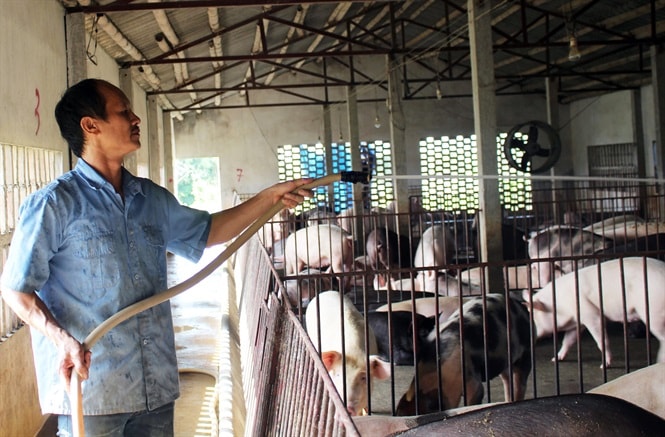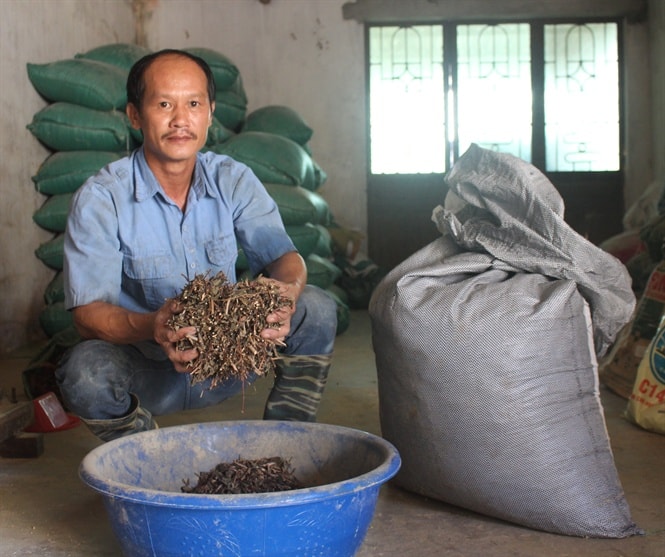Large-scale pig farmer using herbs
The pig herd of Mr. Nguyen Van Thuc's family (Hamlet 4, Truc Thai Commune, Truc Ninh District, Nam Dinh) always maintains a total herd of more than 400 pigs, fed mainly soybeans, rice bran, corn, dried fish and yeast.
Raising pigs with herbs
To help pigs' bodies increase their resistance and immunity to diseases, ensuring clean products, Mr. Nguyen Van Thuc (Hamlet 4, Truc Thai Commune, Truc Ninh District, Nam Dinh) has researched documents, books and newspapers and added herbs to the animal feed processing stage.
 |
| Mr. Thuc bathes the pigs. |
Coming to the beginning of hamlet 4, asking about the clean pig farming model of Mr. Thuc's family, everyone knows. Because, he is the first person in Nam Dinh province to raise clean pigs using herbs.
Thuc said he was born into a farming family. In 1992, after completing his military service, he returned to his hometown to start a business, doing odd jobs to make a living but his income was not much. In 1995, he started a family, life was difficult, and he had no capital. After many discussions, he and his wife decided to get rich by raising pigs using organic methods, ensuring both quality and food safety.
With support and favorable conditions from the local government, Mr. Thuc and his wife rented nearly 4,000m2abandoned public land, then built a pig farm with a scale of nearly 50 pigs.
“After careful discussion, my wife and I decided to borrow money from relatives to build a barn to raise clean pigs using organic methods, suitable for the family's conditions and circumstances at that time,” said Mr. Thuc.
 |
| The herbs are dried by Mr. Thuc before being ground with other ingredients. |
After a while, realizing that the couple's way of getting rich was very effective, Mr. Thuc continued to expand the scale of livestock farming, built more barns, designed according to the Thai barn model, ensuring environmental hygiene.
He temporarily put aside his housework, diligently traveled to neighboring provinces to learn more about livestock farming techniques and to study and visit good models and practices to apply to his family's model. From there, the scale of livestock farming gradually expanded, the number of pigs increased from 50 to 100 and then to nearly 300.
Since 2010, his family's pig herd has maintained a total of more than 400 pigs, fed mainly soybeans, rice bran, corn, dried fish and yeast. In 2015, through research on documents and books, he began adding some herbs to the feed processing to help the pigs increase their resistance and immunity to diseases.
According to Mr. Thuc, when added to food, herbs have the effect of preventing diseases, detoxifying, and fighting bacteria for pigs very well; releasing heavy metals (iron, copper, zinc) and replacing antibiotics. In addition, the quality of the meat is better, firm, crispy, aromatic and the lean meat has a natural red color.
During the breeding process, Mr. Thuc added EM probiotics (purchased at the Vietnam Agricultural Academy) to the pig feed to increase nutrient absorption. In addition, he also used secondary EM probiotics to treat the barn environment and eliminate odors.
Mr. Thuc added that in 2015, his family's food safety pig farming model participated in the project to develop lean pig farming in the direction of VietGAHP. This is one of 5 models nationwide that were put into testing by the Vietnam Institute of Water Resources (Ministry of Agriculture and Rural Development) on wastewater treatment. Through the institute's assessment, it showed good results, with wastewater from the biogas tank reaching the allowable threshold.
“Currently, the market for clean pork that my family supplies is mainly in Nam Dinh, Ha Nam and Hanoi. Because we raise clean pigs according to the correct process from the first stage of importing the breed until they are sold, many convenience stores buy the pork,” said Mr. Thuc.
According to Agriculture Newspaper
| RELATED NEWS |
|---|

